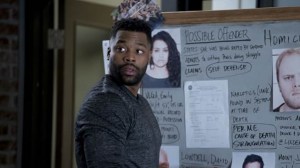
Reflecting upon Quentin Tarantino‘s now complete “revisionist history trilogy,” it’s another Tarantino film that phrases a core theme of this trilogy perfectly, when John “The Hangman” Ruth says, “You only need to hang mean bastards, but mean bastards you need to hang” in The Hateful Eight. All of the films in this trilogy—Inglourious Basterds, Django Unchained, and Once Upon a Time… in Hollywood—illustrate that idea in fashions both nuanced and blunt. Each of these films transport audiences to a familiar events focused on varying degrees of historic atrocity allowing victims or those adjacent to victims to deliver varying degrees of bloody vengeance. Fictional Nazis, American slaveholders, and the Manson Family have all now experienced mayhem, cruelty, and destruction in Tarantino’s scripts. However, there’s much more to those sequences than fantasy fulfillment focused on the past.
Videos by ComicBook.com
There is certainly an element of catharsis within each of these films. While far from a consensus, a substantial portion of Tarantino’s audiences have responded positively to the punishment delivered to various criminals. Plenty of other films have addressed the Holocaust and chattle slavery, but very few have used that subject to deliver almost divine vengeance upon the perpetrators of these crimes; none have done so with the style and skill of Tarantino and his crew. There’s a greater complexity to the politics beneath these visceral, gleeful revenge sequence, one that has been clarified over time.

Inglourious Basterds was the first installment in this thematic trilogy, released almost 10 years ago in 2009, and yet it reads like a film specifically commenting on 2019 in a post-Trump, post-Charlottesville era. This is also the film that serves most clearly as a warning. Not all of the deaths in Inglourious Basterds are joyous, especially when compared to Django Unchained and Once Upon a Time… in Hollywood. After the two central plotlines of the film are unveiled—Shoshana’s story beginning with the execution of her family and the Basterds with Lieutenant Aldo Raine’s pep talk of scalping Nazis—the Nazis to be executed are presented in a generally human fashion. Those who are given any dialogue before being dispatched typically present some sympathetic features. A captured sergeant refuses to provide information on his fellow soldiers and accepts his execution in a fashion that is coded as noble, like a brave American soldier refusing to talk, until the very moment his skull is shattered by a baseball bat and the scene switches to a mood of revelry.
The most sympathetic death occurs in an underground tavern rendezvous that goes arrive due to the attentions of a Gestapo agent. A group of soldiers celebrating one of their own becoming a father also occupy the tavern and are almost all killed in the resulting shootout. Only the new father, Wilhelm, and actress-turned-Ally spy Bridget von Hammersmark survive. Wilhelm has been presented as sympathetic up until this point, playing and drinking with his friends, then begging for his life to spend it with his child. Von Hammersmark shoots Wilhelm the moment he lowers his guard, however, killing him after a hostage exchange is negotiated. Removed from all context, this action appears pointless; von Hammersmark’s fate and the ever-present reminder that all of these enemies are also Nazis removes that notion.

In the film’s final chapter, von Hammersmark is killed by Hans Landa at a movie premiere in an excruciatingly long shot of strangulation. Later in the same climax, Shoshana is killed as well when she briefly shows remorse for killing Private Fredrick Zoller who is able to shoot her when she draws too near. This murder of another woman opposed to the Nazi regime by another Private First Class soldier, one shown to be thoroughly corrupted by Nazi ideology, seems to justify von Hammersmark’s earlier aggression and lack of remorse showing it to be prescient in another scenario.
Tarantino even humanizes the film’s most notable antagonist, Landa, in spite of his proclivities for torture, both physical and psychological. Christoph Waltz’s performance renders Landa with intelligence, humor, skill, and charm. He delivers the detective’s monologue from a parlor scene in the film’s first scene; he later speaks and bounces with infectious joy as he negotiates the destruction of the Fourth Reich. Tarantino allows Landa to tempt audiences into liking the character, but never leaves the story’s perspective on the manner unclear. Almost every sympathetic scene is followed by an act of incredible cruelty, like the strangulation of von Hammersmark. Landa never disguises that he is a Nazi, he only cloaks what that means in wit and cheer. His and the film’s final moments show nothing but disdain for Landa, not even providing an iota of sympathy for Waltz’s performance, as a swastika is carved into his forehead in a long, lingering close up.
This treatment of one of history’s evilest “mean bastards,” from leadership to so many privates, portrays a complete lack of sympathy for Nazis as a virtue of the highest order. The extended sequences of violence leave no doubt that Inglourious Basterds morality in this specific area is black and white. Extended runtimes, long shots, ultra violence, comedy, and humiliation transform the destruction of all Nazis a source of celebration. The same style is present in the deaths of slavers and the Manson killers in later installments.

There’s even less of a veneer provided for Calvin Candie, the primary antagonist of Django Unchained. Leonardo DiCaprio is provided with makeup and costuming that doesn’t allow audiences to forget that this is one of Hollywood’s biggest movie stars, someone considered a heartthrob for most of his time on Earth. The moment he smiles this facade is undone, his teeth look as rotten as his sugary last name could make ironic. A quick temper, dull sense of humor, and ugly sneer make sure that any charming effects never linger. This exaggerated exterior ugliness permeates most of the slavers that audiences encounter building additional tension and discomfort before Tarantino’s familiar brand of revenge violence appears.
Tex Watson, Susan Atkins, and Patricia Krenwinkel—the three individuals instructed by Charles Manson to carry out the Tate murders—are portrayed by young, attractive stars Austin Butler, Mikey Madison, and Madisen Beaty. Before they appear on Cielo Drive, the film shows them on Spahn Ranch. This setting becomes increasingly uncomfortable as it descends into a Texas Chainsaw Massacre-style hell, complete with a horrifying kitchen. When these three are shown entirely in black, they already seem to smell as ugly as their car appears. Every sentence uttered doesn’t help their case either. When they are finally stopped in the film’s climax, there has never even been temptation that the audience should sympathize with them while they are beaten, bitten, and blazed.
Across all three of these scenarios, there is an increasing willingness to punish the selected villains and fewer temptations for any sympathy or compromise. It’s clear that when it comes to Nazis, American slaveholders, and Manson’s mass murderers there is a line that cannot be crossed, choices and actions that human beings cannot return from. Considering the severity of that judgment, it seems appropriate that such extreme atrocities were selected for the treatment. The notion that World War II war criminals and these other examples are “mean bastards you need to hang” is not a difficult case to make. There wouldn’t be any surprises in a national poll regarding support for a film about killing Hitler. This theme is not simply an excuse to enact cinematic violence, however, it’s historical revisionism that is always about the present.
The notion that Nazis should be shown no tolerance might have been met largely with a shrug in 2009, but it is now central to debates about social media regulation and Nazi rallys in Charlottesville. Inglourious Basterds was commenting on the already too present white supremacist groups existing in its own time, its response to that ideology now seems prescient in the age of “very fine people on both sides.” Django Unchained‘s Christmas release date in 2012 wasn’t certain to be set after the reelection of Barack Obama. It was produced in the period in which “Birtherism” emerged and racial tensions were inflamed by Fox News, calling out the “Mean Basterds” of the past as they persisted with new methods of oppression and new language for it. Now Once Upon a Time… in Hollywood takes aim at some of the most notorious Baby Boomers to ever exist, just as the same generation is responsible for most of the chaos in Washington, D.C. (as politicians and voters).
None of the films draw clear parallels to modern figures, and this allows the movies to more easily focus on brutalizing specific ideologies and practices shown to be historical evils. None of them are calls to violence today. Instead, they only encourage audiences to practice the same mental gymnastic conducted in the theater, acknowledging that some ideas should be shown no sympathy, only mockery and disdain. As white supremacist and racist ideologies reemerge in new forms, that approach of not tolerating some ideas has seemingly become a more popular idea and one celebrated by Tarantino’s “revisionist history trilogy.” If there’s anything these films are certain of it’s that “You only need to hang mean bastards, but mean bastards you need to hang.”








